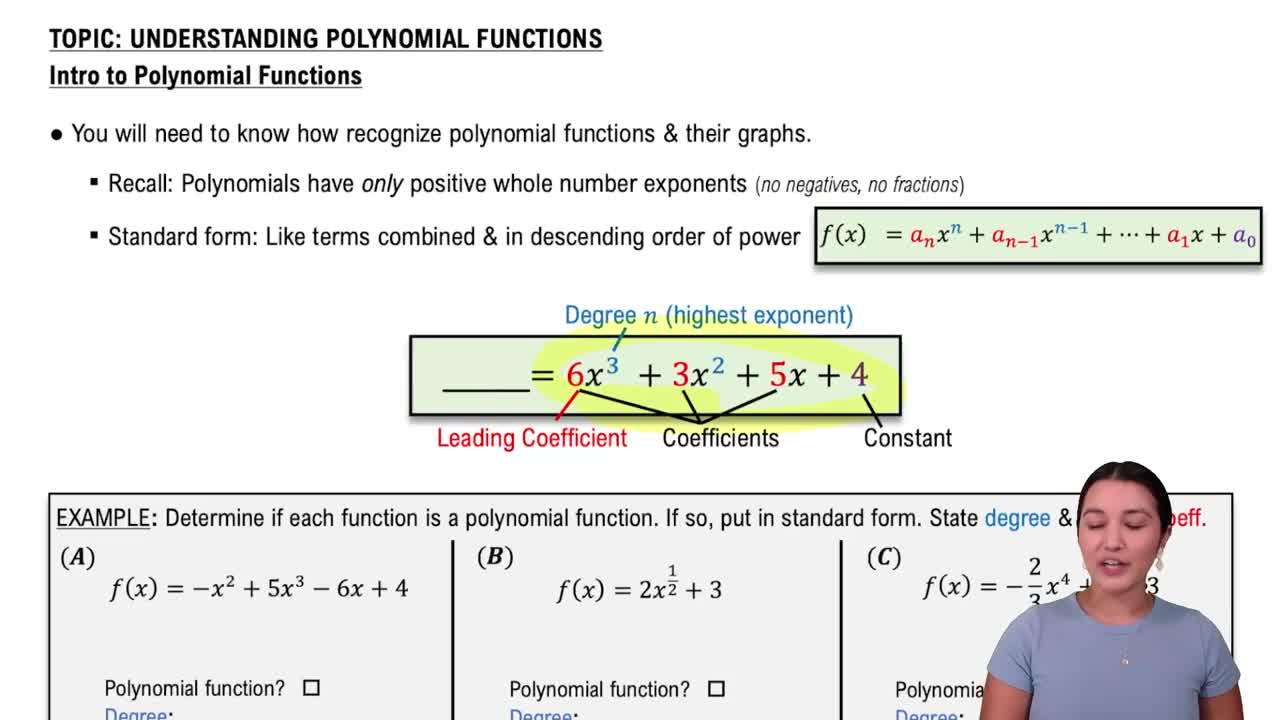Table of contents
- 0. Review of Algebra4h 16m
- 1. Equations & Inequalities3h 18m
- 2. Graphs of Equations43m
- 3. Functions2h 17m
- 4. Polynomial Functions1h 44m
- 5. Rational Functions1h 23m
- 6. Exponential & Logarithmic Functions2h 28m
- 7. Systems of Equations & Matrices4h 6m
- 8. Conic Sections2h 23m
- 9. Sequences, Series, & Induction1h 19m
- 10. Combinatorics & Probability1h 45m
3. Functions
Intro to Functions & Their Graphs
Problem 1a
Textbook Question
In Exercises 1–30, find the domain of each function. f(x)=3(x-4)
 Verified step by step guidance
Verified step by step guidance1
Identify the type of function given. The function \( f(x) = 3(x-4) \) is a linear function.
Recall that the domain of a linear function is all real numbers because there are no restrictions on the values that \( x \) can take.
Consider any potential restrictions. For linear functions, there are no denominators or square roots that could restrict the domain.
Conclude that since there are no restrictions, the domain of \( f(x) = 3(x-4) \) is all real numbers.
Express the domain in interval notation: \((-\infty, \infty)\).
Recommended similar problem, with video answer:
 Verified Solution
Verified SolutionThis video solution was recommended by our tutors as helpful for the problem above
Video duration:
1mPlay a video:
Was this helpful?
Key Concepts
Here are the essential concepts you must grasp in order to answer the question correctly.
Domain of a Function
The domain of a function refers to the set of all possible input values (x-values) for which the function is defined. For polynomial functions like f(x) = 3(x - 4), the domain typically includes all real numbers, as there are no restrictions such as division by zero or square roots of negative numbers.
Recommended video:

Domain Restrictions of Composed Functions
Polynomial Functions
A polynomial function is a mathematical expression involving a sum of powers in one or more variables multiplied by coefficients. The function f(x) = 3(x - 4) is a linear polynomial, which is a specific type of polynomial of degree one. Polynomial functions are continuous and defined for all real numbers.
Recommended video:

Introduction to Polynomial Functions
Graphing Linear Functions
Graphing linear functions involves plotting points that satisfy the function's equation and connecting them to form a straight line. The function f(x) = 3(x - 4) can be rewritten in slope-intercept form as f(x) = 3x - 12, indicating a slope of 3 and a y-intercept of -12. Understanding the graph helps visualize the domain and behavior of the function.
Recommended video:

Graphs of Logarithmic Functions

 5:2m
5:2mWatch next
Master Relations and Functions with a bite sized video explanation from Nick Kaneko
Start learningRelated Videos
Related Practice






